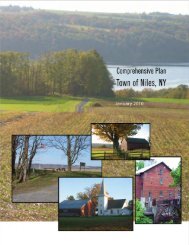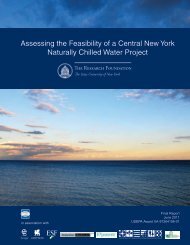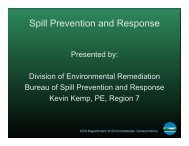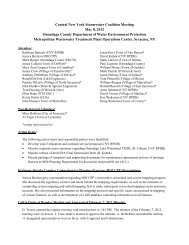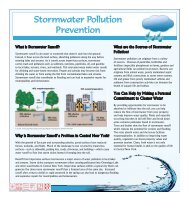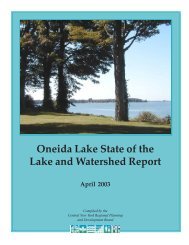A Management Strategy for Oneida Lake and its ... - CNY RPDB Home
A Management Strategy for Oneida Lake and its ... - CNY RPDB Home
A Management Strategy for Oneida Lake and its ... - CNY RPDB Home
Create successful ePaper yourself
Turn your PDF publications into a flip-book with our unique Google optimized e-Paper software.
people are still building in low-lying areas simply by raising their structures <strong>and</strong> driveways.<br />
Recommendation: Identify flood plain <strong>and</strong> flood prone areas of <strong>Oneida</strong> <strong>Lake</strong> <strong>and</strong> discourage<br />
municipalities, developers <strong>and</strong> l<strong>and</strong>owners from inappropriate development within flood prone<br />
areas. Develop strategies to educate individuals <strong>and</strong> groups to the fact that <strong>Oneida</strong> <strong>Lake</strong> is a<br />
regulated natural body of water <strong>and</strong> not a man-made reservoir.<br />
Potential Responsible Organizations: NYS DEC, OLWAC, <strong>CNY</strong> <strong>RPDB</strong><br />
Recommendation: Encourage shoreline <strong>and</strong> upl<strong>and</strong> watershed municipalities to:<br />
– En<strong>for</strong>ce local laws that prohibit new development in flood prone areas;<br />
– Adopt ordinances that prevent new development within flood prone areas <strong>and</strong> along<br />
riparian corridors in an ef<strong>for</strong>t to protect flood prone areas <strong>and</strong> fisheries habitat in municipalities<br />
that do not presently have adequate local laws;<br />
– Follow shoreline protection guidelines (Article 15 NYS DEC regulations) when construction<br />
projects are planned.<br />
– Comply with regulations in order to take advantage of FEMA’s flood mitigation grant<br />
program;<br />
– Educate developers <strong>and</strong> the general public on the correct use of flood <strong>and</strong> elevation maps<br />
when development plans are considered (DEC, FEMA, DOS).<br />
– Educate realtors, builders, homeowners, architects, <strong>and</strong> code en<strong>for</strong>cement officers on<br />
building code requirements or techniques specifically designed to protect structures in flood<br />
prone areas.<br />
Potential Responsible Organizations: NYS DEC <strong>and</strong> local municipalities<br />
Recommendation: Encourage municipal participation in FEMA’s Flood Hazard Mitigation<br />
Program, specifically in terms of flood proofing <strong>and</strong> retrofitting existing structures. Distribute<br />
NFIP educational literature <strong>and</strong> hold workshops that describe methods to flood-proof structures<br />
in flood prone areas.<br />
Potential Responsible Organizations: FEMA, NYS DEC, Planning<br />
B. <strong>Lake</strong> Level <strong>Management</strong><br />
• PROBLEM: There is a lack of underst<strong>and</strong>ing of the response of precipitation <strong>and</strong> snowmelt<br />
throughout the <strong>Oneida</strong> <strong>Lake</strong> watershed to <strong>Oneida</strong> <strong>Lake</strong> levels. There is inadequate<br />
data available, including real-time gauging of the streams tributary to <strong>Oneida</strong> <strong>Lake</strong>, realtime<br />
precipitation gauging <strong>and</strong> snow monitoring at adequate locations throughout the watershed.<br />
Further, a robust hydrologic model, linking these inputs with the fixed stagestorage<br />
relationships on <strong>Oneida</strong> <strong>Lake</strong> coupled with the variable discharge capacity of the<br />
<strong>Oneida</strong> River does not presently exist.<br />
page 46<br />
Chapter 3: Priority Areas



